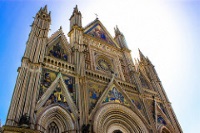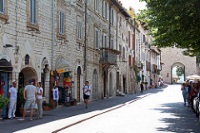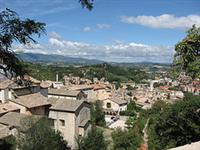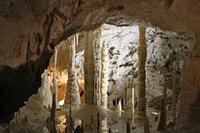Things to do in Umbria
Birthplace of Saint Francis in the 12th century and home to the incredible Basilica di San Francesco, Assisi is one of Italy's most celebrated attractions and the main draw for visitors to Umbria. It's a place with a palpably holy atmosphere, with the countless art treasures in the Basilica alone enough to justify an Umbrian holiday. The medieval fortress town of Orvieto is another very popular destination in Umbria, as is the picturesque ancient town of Spoleto, which was established by the Romans in the 3rd century BC.
By contrast, the capital city of Perugia is not that well known among travellers despite being an ancient Etruscan settlement, and reputed in Italy as a centre for art and culture. Visitors to Perugia will find it a charming destination of coloured houses, vast greenery and spring breezes, as well as enchanting gothic architecture and Renaissance frescoes. The city of Terni, in southern Umbria, also has much to offer, as there are a number of archaeological sites to explore. Terni is best known to travellers for the magnificent Cascata delle Marmore, an artificial waterfall created by the Romans that remains one of the tallest man-made waterfalls in the world. The Umbrian city of Gubbio draws visitors with its incredible street art and delightful medieval town center, which has several scenic terraces that provide breathtaking views of the surrounding countryside.
Umbria is not as packed with tourists as some other regions of Italy, which allows visitors to sightsee in relative peace and enjoy the rustic, laid-back charms of the area without the crowds that can prove so frustrating in the big Italian cities. The best time to visit Umbria is in the shoulder seasons of spring and autumn (April to May and September to October).

Orvieto
The medieval fortress town of Orvieto is dramatically perched on a hilltop overlooking the Umbrian countryside. It's thought to have been an important centre for Etruscan civilisat…
Orvieto
The medieval fortress town of Orvieto is dramatically perched on a hilltop overlooking the Umbrian countryside. It's thought to have been an important centre for Etruscan civilisation and many impressive artefacts can be viewed in its archaeological museum. The town remains almost unchanged since medieval times, and even in summer is not too packed with tourists.
The 13th-century Duomo of Orvieto, with its magnificent facade and frescoes, dominates the skyline. Visitors should also take time to wander around the town's backstreets to find hidden gems and enjoy amazing views over the city walls and battlements. The best restaurants are tucked away in the side streets off the main square.

Assisi
The picturesque hill town of Assisi is famous as the birthplace of St Francis, a 12th-century monk who founded the Franciscan order, which is devoted to practices of asceticism, fr…
Assisi
The picturesque hill town of Assisi is famous as the birthplace of St Francis, a 12th-century monk who founded the Franciscan order, which is devoted to practices of asceticism, frugality and chastity. Tourists and pilgrims flock to the bustling town for inspiration and worship, and a multitude of annual conferences, festivals and other religious activities. Assisi is a visual spectacle of shimmering white marble buildings perched halfway up Mount Subasio. The town is set against the backdrop of the towering 14th-century hill fortress of the Rocca Maggiore, a landmark with which to orientate oneself from inside the city's medieval ramparts.
One of the most loved and visited churches in Italy is the 13th-century Basilica di San Francesco, which contains frescoes by Giotto commemorating the life of St Francis. Giotto is regarded as the father of European painting and the first of the great Italian masters.
Other notable works include paintings by Pietro Lorenzetti and Simone Martini's frescoes based on the life of St Martin. St Francis's tomb rests below the lower church, while other popular sights include the 13th-century Basilica di Santa Chiara, the 12th-century Romanesque Duomo di San Rufino and the Eremo delle Carceri, a monastery situated in the woodland outside Assisi.
Assisi is a beautiful city with winding streets, Roman ruins and magnificent churches, feeling like it has changed little since medieval times. The greatest gems are the small medieval treasures and glorious views to be found all over the small city.

Spoleto
The beautiful town of Spoleto was established by the Romans in the 3rd Century BC, and many Roman buildings, ruins and artefacts remain, including the Coliseum and the Church of Sa…
Spoleto
The beautiful town of Spoleto was established by the Romans in the 3rd Century BC, and many Roman buildings, ruins and artefacts remain, including the Coliseum and the Church of San Salvatore, which dates from the 4th Century, making it one of the oldest churches in the world. The medieval castle and the cathedral dominate the well-preserved Upper Town: the Duomo di Spoleto has a lovely facade with eight rose windows, while inside there are beautiful frescos by Filippo Lippi.
Another popular attraction in Spoleto is the impressive Tower's Bridge, which was built in 1350 AD and is still traversable today. The church of San Pietro can be found in the wooded hills a short trip out of town. This church served as the cathedral of Spoleto until 1067, and sports some of the best Romanesque carvings in Italy.

Frasassi Caves (Grotte di Frasassi)
Located just 50 miles (80km) from the region of Umbria, the city of Genga's Frasassi Caves are considered to be some of the most wondrous in Italy. A remarkable cave system compris…
Frasassi Caves (Grotte di Frasassi)
Located just 50 miles (80km) from the region of Umbria, the city of Genga's Frasassi Caves are considered to be some of the most wondrous in Italy. A remarkable cave system comprised of limestone dissolved over millennia, it's fitted with safe, comfortable walkways and theatrical lighting to bring the otherworldly stalactites and stalagmites into greater relief.
Visitors will experience a genuine thrill while travelling down as the temperature drops and breath begins to mist. The overwhelming silence is broken only by the resonance of dripping water. One of Italy's most talked-about tourist attractions in recent years, tourists stopping off in Umbria should be sure to make the short trip to the Frasassi Caves.
Website www.frasassi.com



